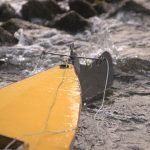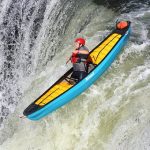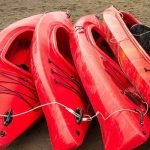What kind of materials do you want in your kayak? Kayaks come in a variety of types to match different purposes. For example, someone who wants to kayak for leisure may want a different type than someone who wants to kayak in the ocean.
The main choices are sit-on-top, sit-inside, recreational, touring, and sea. Each has different pros and cons in terms of stability, speed, and materials. Another factor to consider is length, as a longer kayak will be faster but less maneuverable, while a shorter kayak will be the opposite.
There are a lot of factors to consider when choosing a kayak, but people often don’t think about important questions like how they will transport and store the kayak.
Folding kayaks are a good option for people who don’t have a lot of storage space, because they can be packed down into a small bag.
They are also easy to transport, since you don’t need roof racks or a trailer. You can even take them on vacation with you.
What Is a Folding Kayak?
A kayak that can be folded and packed away is called a folding kayak. These kayaks are made from different materials, including skin-on-frame kayaks with take-apart aluminum or wooden frames and fabric outers, origami-style folding kayaks, nesting kayaks, and inflatables.
The number of people living in cities is increasing, which makes it difficult to find storage for large items like kayaks. Foldable kayaks are a good solution to this problem because they are easier to transport and take up less space.
The main reason to get a folding kayak is the compact size. These kayaks can be stored in an oversized backpack, thrown in the trunk of a car, or carried on a train.
They are easy to assemble and can be on the water in as little as 10 minutes.
Foldable kayaks are becoming increasingly popular due to their practicality and versatility, with Klepper kayaks being some of the first to be mass-produced for consumers back in the early 1900s.
100 years later and the popularity of these kayaks doesn’t look like it’s going to fade away anytime soon.
Are Folding Kayaks Any Good?
If you’re short on storage space, or need to take your kayak with you on public transportation, a folding kayak is a great choice.
They’re also perfect for travelers who want to bring their kayak along on road trips or to fly-to destinations. Many folding kayaks have the same capabilities as other types of recreational or touring kayaks when it comes to paddling.
Foldable Kayak vs Hardshell
Folding kayaks have a number of advantages over hardshell kayaks. They are usually lighter and more portable, meaning they are easier to store and transport.
In addition, they have the potential to outperform hardshell kayaks in terms of speed and efficiency, although this may not always be the case in practice.
The outfitting in hardshell kayaks is usually more adjustable than in folding kayaks, which makes them more comfortable. This includes the seats, foot rests, and thigh braces.
Foldable vs Inflatable Kayak
The majority of people who discuss foldable kayaks are describing ones that don’t need to be inflated and are more stable than inflatables.
Furthermore, they provide a experience much like kayaks with a hardshell. On the other hand, inflatables are not as swift and aren’t ideal for lengthy voyages or rougher waters.
Folding kayaks are usually more expensive than inflatable kayaks, but both have affordable models that are good for beginner kayakers.
Inflatable kayaks are usually quicker to set up, but origami-style folding kayaks don’t need an air pump and can be just as fast to get on the water.
Lightest Foldable Kayak
There are three different kayaks mentioned that are all on the lighter side.
The first is the Oru Inlet, which is made out of a lightweight material and only weighs 20 pounds.
The next is the Pakboats Puffin Saco, which is a traditional skin-on-frame kayak that also only weighs 20 pounds.
The last kayak mentioned is the Advanced Elements AdvancedFrame Ultralight, which weighs even less at only 17.5 pounds.
This kayak is a hybrid of an inflatable and frame kayak, which makes it even more lightweight and easy to carry.
Are Folding Kayaks Worth It?
Carbon fiber kayaks are more expensive than other types of kayaks, but they are also more durable. A kevlar or carbon fiber kayak will cost around $2,500 to $3,000.
I used to think that folding kayaks were just a gimmick, but after trying out a TRAK kayak, I realized that they provide almost the same performance as fixed shell kayaks, while also being much more transportable and compact.
Flotation in Folding Kayaks
It’s important to have flotation in your kayak, especially if you’re in rough water or far from shore. Flotation bags are a good option if your kayak doesn’t have bulkheads. Bulkheads are walls that divide the kayak into three compartments, which are usually accessed by hatches.
If you have to get out of the kayak and swim, the middle compartment will flood, but the front and back compartments will stay dry, keeping the kayak from sinking.
I’m going to put a dry bag with floatation properties in the front frame, and another one in the back frame. The best part about these dry bags is that they can also be used as floatation devices.
The dry bags inside the boat are for floatation in case of emergency. You can’t fit a lot of gear in them, so it’s also a good idea to have dry bags on the deck, which is why there are bungees there.
I’m going to put these float bags in and get some air in them.
I don’t need to pump them up too much, just enough so they fill up easily. Then I can pump them up. I blow them up with this hose.
There, that’s one airbag in. I could have put it within the frame before shoving the frame forward, which would have been easier, but this will work too.
Some Benefits of a Folding Kayak
The following text is about the kayak’s weight and how it affects performance. It’s pretty light. It’s lighter than a normal polyethylene kayak, but maybe not lighter than a carbon kayak.
Even so, it’s a great weight and easy to carry around. The design is quite high performance due to the jacking nature of the frames, which pushes the skins out and makes the kayak very taut.
I’ve paddled it in all sorts of conditions, from big ocean surf in Jamaica to big white water. I’ve tested this thing in a variety of conditions, run over a lot of rocks and this skin is incredibly durable.
One of the things that attracted me to the TRAK kayak was the fact that it has a hydraulic jack on the bottom of the keel line.
This allows you to control the rocker of the kayak, which makes it more maneuverable.
Shopping for a Used Foldable Kayak?
Here are a few tips for shopping for a used folding kayak on Craigslist:
-Always meet the seller in person to inspect the kayak before making a purchase.
-If possible, take the kayak out for a test paddle to make sure it suits your needs.
-Be sure to negotiate the price of the kayak based on its condition.
Know What Kind of Fold-up Kayak You Are Buying
Some kayaks that are no longer being made are still valuable because they are classic designs. Others may not be as valuable because they are knock-offs of more popular kayaks.
If you are unsure of the value of a kayak, ask the seller for more information.
The comprehensive Paddling Buyer’s Guide lists detailed information for folding kayaks, both contemporary and classic.
You can also ask the seller how and where they used the kayak, which will give you a sense of what it’s most appropriate for and how many nautical miles it’s seen.
Assemble and Inspect
It is advisable to meet with the seller in order to fully assemble the kayak the first time, in order to get an accurate estimate of set-up time for a more experienced user.
Folding kayaks come in a range of designs, from the simplest origami-style folding kayaks to more complex “skin-on-frame” styles that use a polyurethane-coated fabric shell stretched over a take-apart aluminum or wood skeleton.
The average assembly time for these kayaks can range from less than 10 minutes to nearly 30 minutes, depending on the design.
After you have found a kayak you like, setting it up will let you know if any parts are missing or broken, and if there is any damage to the kayak.
If parts are missing or damaged, you might be able to get replacement parts from the manufacturer.
If the kayak’s fabric is ripped, heavily faded, moldy, or the coating on the inside is peeling, it is probably best to continue looking for a different kayak.
Take It for a Test Paddle
Once you have assembled the foldable kayak, take it out for a spin on the water. This is the best way to see if it is a comfortable fit and if it performs well. Remember to bring a paddle and lifejacket (unless they are included in the sale).



